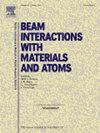Computational simulation of primary damage in silicon carbide under ions irradiation
IF 1.4
3区 物理与天体物理
Q3 INSTRUMENTS & INSTRUMENTATION
Nuclear Instruments & Methods in Physics Research Section B-beam Interactions With Materials and Atoms
Pub Date : 2025-02-01
DOI:10.1016/j.nimb.2024.165597
引用次数: 0
Abstract
Silicon carbide (SiC) and its composites are promising structural materials for advanced nuclear energy applications. Due to the lack of advanced nuclear energy devices, ion beam irradiation is widely used to emulate reactor neutron irradiation. At the same time, different types of ion beam irradiation could produce different primary knock-on atom (PKA) energy spectra. PKA energy determines cascade damage sizes and defect clustering distributions, which may influence the irradiated materials’ long-term microstructural evolution and mechanical properties. This work used SRIM and Geant4 software to investigate the PKA characteristic produced by 1 MeV different noble gas ions and neutrons in the silicon carbide. The PKA energy spectra and weighted energy spectra of C and Si are calculated, respectively. The simulation results show that the PKA energy spectra calculated by the two kinds of software have obvious differences, but the weighted average PKA energies are close to each other. Simulation results verified that the weighted average PKA energy of Kr and Xe ion irradiation is close to that weighted average PKA energy spectrum for neutron irradiation of advanced reactors. The simulation results provide scientific references for understanding the difference in irradiation effects of different types of ions and also provide fundamental bases for the simulation of primary defect damage and long-term defect evolution in irradiated SiC.
离子辐照下碳化硅初损伤的计算模拟
碳化硅及其复合材料是一种很有前途的先进核能结构材料。由于缺乏先进的核能装置,离子束辐照被广泛用于模拟反应堆中子辐照。同时,不同类型的离子束辐照可产生不同的初级撞击原子能谱。PKA能量决定了级联损伤大小和缺陷聚类分布,影响辐照材料的长期微观组织演变和力学性能。本文利用SRIM和Geant4软件研究了1 MeV不同稀有气体离子和中子在碳化硅中产生的PKA特性。分别计算了C和Si的PKA能谱和加权能谱。仿真结果表明,两种软件计算的PKA能谱有明显差异,但加权平均PKA能谱接近。仿真结果证实,Kr和Xe离子辐照的加权平均PKA能谱与先进反应堆中子辐照的加权平均PKA能谱接近。模拟结果为了解不同类型离子辐照效应的差异提供了科学参考,也为模拟辐照SiC的初级缺陷损伤和长期缺陷演变提供了基础依据。
本文章由计算机程序翻译,如有差异,请以英文原文为准。
求助全文
约1分钟内获得全文
求助全文
来源期刊
CiteScore
2.80
自引率
7.70%
发文量
231
审稿时长
1.9 months
期刊介绍:
Section B of Nuclear Instruments and Methods in Physics Research covers all aspects of the interaction of energetic beams with atoms, molecules and aggregate forms of matter. This includes ion beam analysis and ion beam modification of materials as well as basic data of importance for these studies. Topics of general interest include: atomic collisions in solids, particle channelling, all aspects of collision cascades, the modification of materials by energetic beams, ion implantation, irradiation - induced changes in materials, the physics and chemistry of beam interactions and the analysis of materials by all forms of energetic radiation. Modification by ion, laser and electron beams for the study of electronic materials, metals, ceramics, insulators, polymers and other important and new materials systems are included. Related studies, such as the application of ion beam analysis to biological, archaeological and geological samples as well as applications to solve problems in planetary science are also welcome. Energetic beams of interest include atomic and molecular ions, neutrons, positrons and muons, plasmas directed at surfaces, electron and photon beams, including laser treated surfaces and studies of solids by photon radiation from rotating anodes, synchrotrons, etc. In addition, the interaction between various forms of radiation and radiation-induced deposition processes are relevant.

 求助内容:
求助内容: 应助结果提醒方式:
应助结果提醒方式:


